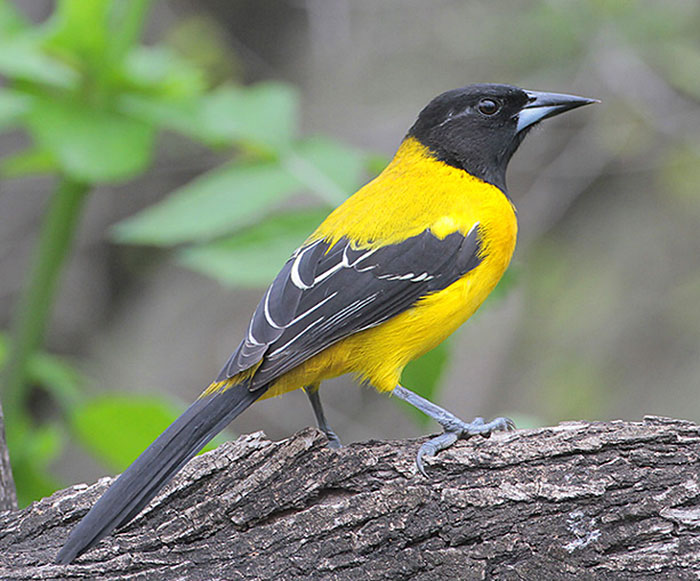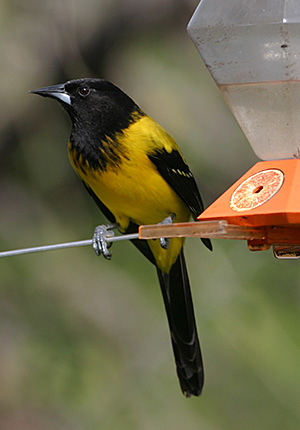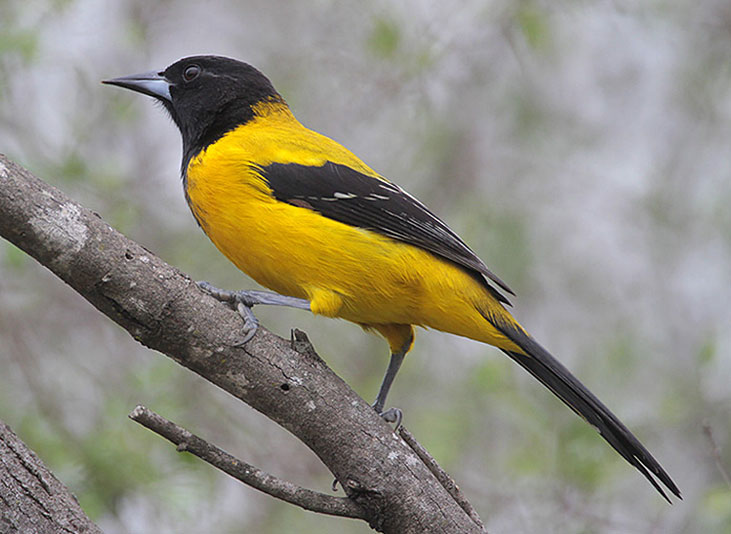Found only in south Texas among U.S. states, the Audubon’s Oriole has a reputation of being secretive and hard to find or study. Bronzed and Brown-headed Cowbirds are certainly able to find Audubon’s Oriole nests, however, as about 50% of nests are parasitized, despite nest defense by the orioles.
Audubon’s Orioles have undergone population declines with clearing of riparian forest and thorn forest. Larger, unfragmented areas of habitat are apparently important for this species, and habitat restoration efforts are promising for conserving the species.
On this page
Description of the Audubon’s Oriole
BREEDING MALE

Photograph © Greg Lavaty
The Audubon’s Oriole is yellow with a black head and breast, black wings with significant white, and a black tail.
Female
Sexes similar.
Seasonal change in appearance
None.
Juvenile
Similar to adults, but duller and lacks the black head and breast.
Habitat
Woodlands.
Diet
Insects and berries.
Behavior
Forages in trees and shrubs, or occasionally at flowers for nectar.

Range
Limited to southern Texas and parts of Mexico.
Fun Facts
Audubon’s Orioles are somewhat secretive, and even when singing may not perch in an obvious location.
Despite its declining population trend, few studies of Audubon’s Orioles have been done.
Vocalizations
The song is a slow whistle made up of a series of notes.
Attracting
Audubon’s Oriole will come to nectar feeders.
Similar Species
Male Scott’s Orioles are similar, but have a black back.
See more: Birds that look like orioles
Nesting
The Audubon’s Oriole’s nest is a woven pouch that hangs from the outer branches of a tree.
Number: 3-5. ?
Color: Pale grayish with darker markings.
Incubation and fledging: ?
– Young hatch at an unknown age.
?- Young fledge (leave the nest) at an unknown age.
Bent Life History of the Audubon’s Oriole
Published by the Smithsonian Institution between the 1920s and the 1950s, the Bent life history series of monographs provide an often colorful description of the birds of North America. Arthur Cleveland Bent was the lead author for the series. The Bent series is a great resource and often includes quotes from early American Ornithologists, including Audubon, Townsend, Wilson, Sutton and many others.
Bent Life History for the Audubon’s Oriole – the common name and sub-species reflect the nomenclature in use at the time the description was written.
now Audubon’s Oriole
ICTERUS GRADUACAUDA AUDUBONJI Giraud
HABITS
Bendire (1895) writes:
This is one of the sixteen new species of birds described by Mr. J. P. Giraud in the Annals of the New York Lyceum of Natural History, in 1841, from specimens collected in Texas in 1838. Some time afterwards Mr. John H. Clark, the naturalist attached to the Mexican Boundary Survey, obtained several specimens near Fort Ringgold, Texas. He reported it as not abundant, and its quiet manners and secluded habits prevented it from being very conspicuous. It was most frequently observed by him feeding on the fruit of the hackberry, but whenever approached while thus feeding it always showed signs of uneasiness, and soon after sought refuge in some place of greater concealment. Usually pairs were to be seen keeping close together, apparently preferring the thick foliage found on the margins of ponds or on the old bed of the river. They did not communicate with each other by any note, and Mr. Clark was struck by their remarkable silence. Their habits seemed to him very different from those of any other Oriole with which he was acquainted .
George B. Sennett (1878) says: “This large Oriole cannot be said to be very abundant on the Rio Grande, although it is by no means rare. I think it is by far more retiring in its habits than any other of the family. If I were to go in search of it I should seek dense woods, near an opening, with plenty of undergrowth, where the Rio Grande Jay loves to dwell.”
As all other naturalists who have visited this fascinating region along the lower Rio Grande have found this handsome, black-headed oriole far from abundant and not conspicuous among the many interesting Mexican species that there extend their ranges into the United States, it is not strange that we saw very few when I visited Brownsville in 1923. What few we saw were in the dense forests along the resacas, or stagnant water courses, the former beds of streams, or in other wooded regions; these usually contained large specimens of mesquite, hackberry, ebony, huisache, and a few palms, with a heavy undergrowth of shrubs, small trees, persimmons, granjenas, coffee beans, and bush morning-glories.
At early morning and again after sunset, these woods resounded with the weird chorus of loud screams from the chachalacas; all day long the white-winged and white-fronted doves filled the air with their tiresome cooing; and the noisy Derby flycatchers often proclaimed their presence with loud, clamorous notes from the treetops; but we did not hear, or failed to recognize, the song of Audubon’s oriole. Frequent glimpses were had of the brilliant green jay and the lovely little Texas kingfisher, but the oriole kept mostly hidden in the foliage.
Our black-headed oriole, as it was formerly called, is a northern race of a Mexican species, which ranges from the lower Rio Grande Valley southward into Tamaulipas and Nuevo Leon in Mexico. The type race (A. g. graduacauda) ranges over the southern portions of the Mexican plateau; it is a smaller bird, with the bill much stouter, shorter, and the culmen more curved; the black of the head and neck is more extensive; there is no white in the wings, and the middle coverts are black instead of yellow; and the tail is entirely black. In our bird the outer edges of the wing quills are edged with white, broadly so on the innermost secondaries, and the greater wing coverts are usually edged with white near the tips; the outer tail feathers, also, are more or less edged and tipped with white.
Nesting: Sennett (1879) was the first to discover the nests and collect authentic eggs of Audubon’s oriole, about which he writes: “This year I was fortunate in obtaining, within our limits, nests and eggs of this large Oriole. Two incomplete sets were found early in May, which enable me to identify a complete set of four obtained last year. The latter set was taken at Hidalgo, Texas; the two former, at Lomita. The three nests were found in heavy timber, some ten or twelve feet from the ground, are haif-pensile, something like those of the Orchard and Bullock’s Orioles, and attached to upright terminal branches. They are composed of dried grasses woven among the growing twigs and leaves, so as to form a matting light and firm. They measure on the inside some three inches in depth and rather more in width.”
Since then, the National Museum has received from William L. Ralph a fine series of the eggs, taken near Brownsville, Texas. Based on this material, Bendire (1895) describes the nest as follows:
The nest of this Oriole is usually placed in mesquite trees, in thickets and open woods, from 6 to 14 feet from the ground. It is a semipensile structure, woven of fine, wire-like grass used while still green, and resembles those of the Hooded and Orchard Orioles, which are much better known. The nest is firmly attached both on the top and sides, to small branches and growing twigs, and, for the size of the bird, it appears rather small. One, now before me, measures 3 inches in depth inside by about the same in inner diameter. The rim of the nest is somewhat contracted to prevent the eggs from being thrown out during high winds. The inner lining consists of somewhat finer grass tops, which still retain considerable strength, and are even now, when perfectly dry, difficult to break. Only a single nest of those found was placed in a bunch of Spanish moss, and this was suspended within reach of the ground; the others were all attached to small twigs.* * *
Nidification begins sometimes early in April, but usually about the last week in this month. Fresh eggs have been taken on April 23 and as late as June 8. Attempts are probably frequently made to rear two broods in a season, but many of them are unquestionably destroyed each year by the Red-eyed Cowbird, as well as through other causes.
Eggs: Bendire (1895) gives the following good description of the eggs:
The number of eggs to a set varies from three to five. Sets of one or two eggs of this Oriole, with two or three Cowbirds’ eggs, seem to be most frequently found, some of the first-named eggs being thrown out to make room.
The eggs differ somewhat in the character of their markings from those of the remainder of our Orioles; they are ovate and elongate ovate in shape, and the shell is rather frail and lusterless. The ground color is either pale bluish or grayish white, and occasionally the egg is only slightly flecked with fine markings and a few hair lines of different shades of brown and dark purple, these being nearly evenly distributed over the surface. In others the ground color is partly obscured with a pale purple suffusion, and more profusely blotched and streaked with different shades of claret brown, purple, ferruginous, and lavender, resembling somewhat certain types of Brewer’s Blackbirds’ eggs, while an occasional set is profusely blotched with coarse, heavy markings of cinnamon rufous and numerous finer spots of the same tint, these almost completely hiding the ground color. The markings are generally heaviest about the larger end of the egg.
The largest egg of the series measures 26.42 by 18.80 millimetres, or 1.04 by 0.74 inches; the smallest, 23.62 by 17.78 millimetres, or 0.93 by 0.70 inch.
Plumages: Chapman (1923b) describes the plumages briefly as follows: “In nestling plumage, Audubon’s Oriole is olive-green above, greenish yellow below, the wings and tail being externally brownish. The black head of the adult is acquired at the postjuvenal (first fall) molt, but the wings and tail are still those of the young bird. This plumage is worn throughout the first nesting season, at the end of which the black wings and tall are acquired and the bird resembles our figure. The female closely resembles the male and often cannot be distinguished from it in color, but usually the back is more olivegreen, less pure yellow than in the fully adult male.”
The above description is correct as far as it goes. In a large series that I have examined, the postjuvenal molt seems to begin early; I have seen a young bird in juvenal plumage that was acquiring a black throat on July 19, and another that had a nearly complete black head on July 14. As stated above, this first winter plumage is worn without much change all through the spring; I have seen birds in this plumage in March, April, May, and June, and as late as July 7. The postnuptial molt of adults is apparently not completed until some time in September; one taken September 3 was still molting wings and tail.
Behavior: The following quotations are taken from some papers sent to John Cassin (1862) by Lieutenant Couch:
The Black-headed Oriole was seen for the first time on the third of March 1858, at Santa Rosaijo rancho, eight leagues west of Matamoras. It had paired, and both male and female were very shy and secluded, seeking insects on the no pal (a species of prickly pear), or among the mimosa trees, never seeming to be at rest, hut constantly on the look-out for their favorite food .
At Charco Escondido, farther in the interior of Tamaulipas, this bird was well known to the ranchcros, who were disposed to give it a bad reputation, stating that it often came to the rancho to steal the freshly-slaughtered heef, hung up to dry in the sun. Whether this was true or not, I had no opportunity of ascertaining; but my acquaintance with the Black-headed Oriole, at this place, I have a particular reason for remembering. * * * It was the day after a severe northern, and the whole feathered kingdom was in motion. My guide soon called my attention to two calandrias, as these birds are called by the Mexicans, which were quietly but actively seeking their breakfast. The male having been brought down by my gun, the female flew to a neighboring tree, apparently not having observed his fall; soon, however, she became aware of her loss, and endeavored to recall him to her side with a simple pout pou-it, uttered in a strain of such exquisite sadness, that I could scarcely believe such notes to be produced by a bird, and so greatly did they excite my sympathy, that I felt almost resolved to desist from making further collections in natural history, which was one of the principal objects of my journey into the country.* * *
My stay in Mexico was not sufficiently protracted to enable me to study the habits of this interesting bird as fully as I could have wished. Generally, its flight is low and rapid, and it seemed to prefer the shade of trees. It was observed almost invariably in pairs, and the male and female showed for each other much tenderness and solicitude. If one strayed from the other, a soft pou-it, soon brought them again together .
Voice: Couch (Cassin, 1862) observed further: “I have never heard the lay of any songster of the feathered tribe expressed more sweetly than that of the present Oriole. At Monterey, it is a favorite cage-bird. The notes of the male are more powerful than those of the female.”
Sennett (18i8) says: “It is a sweet singer, never very generous with its music, and only singing when undisturbed .
“I remember once sitting in the edge of a woods, watching the movements of some Wrens just outside, the only sounds to be heard in the woods being the discordant notes of the Rio Grande Jay, when suddenly, from over my head, there burst upon my ear a melody so sweet and enchanting that I sat entranced, and, listening, forgot all else. I soon discovered the whereabouts of the singer, and watched him as he flitted about from branch to branch, singing his wonderful song. I have no power to describe a bird’s song, least of all this Oriole’s.”
Field marks: Audubon’s oriole should be easily recognized as a large oriole, with a wholly black head and neck, and with black wings and tail, the rest of the body being yellow, rather more greenish yellow on the back and clearer yellow below, but without any orange tinge. The sexes are practically alike .
Enemies: Audubon’s oriole probably has as many enemies as other birds, but the cowbirds seem to be as troublesome to it as any of which we have record. Bendire (1895) says that it “seems to be greatly imposed upon by the Red-eyed Cowbird; half of the sets in the collection contain from one to three of these parasitic eggs; but none of the equally common Dwarf Cowbird have, as far as I am aware, yet been found in them.”
Herbert Friedmann (1929) writes: “Near Brownsville, Texas, I found two nests of the Audubon’s Oriole; both of them containing eggs of the Red-eyed Cowbird. One had two eggs of the Oriole and one of the Red-eye. The other contained one Red-eyed Cowbird’s egg and one of the Dwarf Cowbird and one of the owner. Both northern races of the Red-eyed Cowbird are parasitic on the Audubon’s Oriole.”
Winter: Audubon’s oriole is mainly resident throughout the year within its breeding range, but it is said to occur in San Luis Potosf in winter, and to wander casually as far north as San Antonio, Tex. H. P. Attwater (1892) called it a “rare winter wanderer” in the latter locality; he secured a fine male there on March 27, 1890, and, on February 13 of the next year, he obtained three specimens out of a flock of 8 or 10; the next day they were all gone, and he did not see them again.
DISTRIBUTION
Range: Southern Texas to Central M6xico .
Breeding Range: Audubon’s oriole breeds from southern Texas (Rio Grande City, Hidalgo, Brownsville) and possibly casually north to Pleasanton and Austwell south at least to central Tamaulipas (Realito, Rio Cruz).
Winter Range: Winters throughout breeding range south to Nuevo Le6n (Mesa del Chipinque, south of Monterrey), San Luis Potosi (Hacienda Angostura), and southern Tamaulipas (Victoria, Tampico).
Casual recorda: R are in south central Texas (San Antonio area).
Migration: Largely a permanent resident. Early spring date north of normal Range: Texas: Lytle, Atascosa County, March 4.
Egg dates: Texas: 15 records, April 23 to June 15; 8 records, May 7 to May 28.


